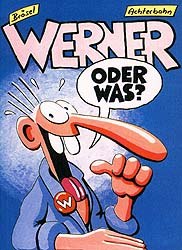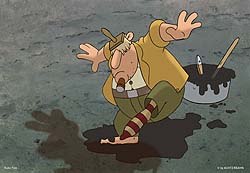Thomas Korn takes a look at the German comic book character that has become a cultural phenomenon and a winning businessventure.
For the third time, Werner, the motorcycle riding, underdog hero, will be appearing on cinema screens across Germany. What does this mean? Does this character represent a key to the mystery of cool, northern-oriented German humor, and a new success strategy for films which are not made in Hollywood? Starting on September 16, the third part of the Werner trilogy, Werner: Volles Rooäää!!!, Werner will once again cause and express different thoughts and feelings on both points.

Who is Werner?
Werner is ugly, selfish, politically incorrect, short-minded, unemployed, and always seeking beer and having fun. The figure represents a specific attitude about the alternative underground scene, about motorbike-rocker-romanticism, and about standing up to authority.
However, the Werner films appear to appeal to all people and ages. Segmentation of groups is difficult, because both young alternative-minded people and general audiences enjoy a movie which provokes laughter and controversy, but does not show insulting hard-core sex or massive violence attacks.
In comparison, this does not mean that people do not like
other entertainment made in Hollywood -- but only children and young adults
really adore super heroes like Superman and Batman, or laugh and weep with
those "sweet beauties" from the movies of Walt Disney. Some time
ago Hamburg shop owner Richard Meyer, when asked about stocking an American
pop culture magazine, explained, "No European gets too excited about
a man dressed up in a black rubber costume, know what I mean?"
Is Werner popular? Indeed! Previous Werner films have even outperformed
big Hollywood movies at the German box office. Slang, crazy characters,
the normal madness of life, irony, and silly nonsense -- all of this is
in Werner. Nevertheless, people go to theaters to relax and laugh. Try to
imagine the flat landscape of Northern Germany, especially for young people:
There are a few jobs, but very often the chances of employment are unsure;
Werner, a fellow without many prospects, offers motorbike trips and chases
vs. dumb country policemen, ironic humor combined with slang-speech, and
fun without serious consequences. Nevertheless, the division of comments
should be mentioned, as Werner has gleaned everything from "worthless
nonsense" from serious film critics to "comic genius" from
fans.
Werner's Humble Beginnings
Werner, originally an easy-going German comic-strip character, roared from the liberal, alternative underground comic scene of the early 1980s to reach a peak as both a phenomenon of German pop culture and business. The first two Werner films were impressively successful in the biggest single European market, Germany. The first one of these, Werner: Beinhart, was produced by Gerhard Hahn Filmproduktion AG and the Hamburg-based company, Trickcompany. The second film, Werner II: Eat My Dust, was made solely by Trickcompany, and is now followed by Werner: Volles Rooäää!!!, which is being produced primarily by Hahn Film again.

Rötger Feldmann, or Brösel, who created the comic
figure in the late 1970s, used the slogan, "Unemployed and having fun."
(Brösel is a nickname for Rötger, and while he does not write
all of the Werner books, the author is always listed as "Brösel.")
Feldmann, who made an incredible career as a business venture capitalist,
was born in 1950. He lost his apprentice job as a lithographist by drawing
inappropriate pictures of his employer. However, he did manage to influence
his co-workers later on to create comic-strip adventures. This humble beginning
has grown. For instance, in September 1988, there is the case of the famous
"Das Rennen" (race), between a motorcyclist, like Werner, and
a red Porsche car (driven by a friend, supervised by German policemen) on
an old airfield in Northern Germany. The publicity stunt attracted more
than 250,000 fans who looked on like the audience of a big Formula-1 spectacle.
This growing franchise forced the creators to expand and in
1997 Achterbahn AG was launched on the German stock exchange. With a booming
product pipeline delivering serials of funny comic-strips, and now movies,
for the fans, the company's shareholder value has increased in only a few
years. More cooperation is on the way with Eichborn Verlag, Frankfurt/Main
ready to merge.
A German merchandising success, Werner has sold more than 11 million comic books. Additional Werner products range from tame mugs and T-shirts, to condoms and cigars. CDs of the films' soundtracks have also sold well. Supported by professional marketing groups, sales have climbed to a few hundred million deutschemarks. Accompanied by this fast growing merchandising effort, Werner has also launched as a new media venture company on the world wide web, with fans eagerly waiting to participate in the latest adventures of their "super hero." With this push, Werner: Volles Rooäää!!! enters the market.... The first movie in 1990 attracted 4.9 million viewers, a number which was bettered with the second movie reaching more than 5 million people in 1996. All of this adds up to not only a growing merchandising business, but also a chance to roll over such popular US features as Batman at the box office. Werner: Volles Rooäää!!! will hit theaters at full speed.
Differences Between The Films
Viewers will see big differences between the first two movies and this new one. Made not only in Germany, but also by creative teams around the world, Werner: Volles Rooäää!!! takes advantage of new technologies in order to deliver a high quality product within a reasonable budget and time frame. Werner: Volles Rooäää!!! director Gerhard Hahn gives credit to improved production systems from US-based companies, specifically in the field of rendering, as well as the use of multiple animation techniques.
Roughly 1100 scenes were animated in a traditional manner, which means 24 drawings per second of film had to be hand-drawn by the animators to guarantee full animation. At the height of production, about 400 animators were giving life to the film's figures. At a sister studio in Saigon, 250 more animators were kept busy as well. Under the guidance of Animation Director Darko Belevski, the heavy design and animation work was done at Hahn Studios in Berlin, Cologne, and Saigon. Well-known animators such as Sahin Ersöz and his crew in Los Angeles, Tahsin Özgür in Istanbul, Canuck Creations in Canada, and still other studios, were a part of the Werner: Volles Rooäää!!! production. For instance, over 700 background keys were made in Asia at Hong Ying Animation in Shanghai, Wang Film in Taipei and with the support of Ruben Romanban and his team in Manila, Philippines. As Head of Production, Ciara Breslin was responsible for keeping track of it all.
However, the traditional side is only half the story... The
computer graphics department of Babelsberg-based company 'b' (which recently
had its main shareholders abandon it) handled 100 animated motorcycle scenes.
In order to animate Werner's movements, the team at company b used a motion-capture
system. The movements of an actor were directly transferred to a computer-animated
model using the motion capture system Flock of Birds/Motion Star from Ascension.
A special rendering process, called cartoon shading, was used to give the
film the right cartoon look so that the CGI would blend well with the traditional
images in the final scenes. The team at company b, Thomas Baumgarten, and
others also worked with the Mental-Ray shader "Toon Ink," a development
from the Berlin based software company.
The many different techniques and software packages that were
used in order to complete the film produced many improvements. These include
motorbike scenes with precise technical details and moving parts (within
moving images); a greater variety of camera angles, such as overhead shots;
moving backgrounds; and special effects that are a technical highlight of
the comic-book-like movie. Yet, these improvements did not result in higher
costs, thanks to the globalization of the production process.
Werner is successful for many reasons, but take the products
for example. Germans are a very-quality-conscious people. Merchandising
articles should express style; furthermore polyester T-shirts shouldn't
fall apart as soon as they are washed! So, if a store owner has quality-oriented
products in their shop, with the Werner (not Warner!) name behind it, they
have a business (and non-fiction story) made in Germany. Warner Bros. and Disney-type productions show standardized, sometimes very well-loved 'toons, as artificial characters, and American-minded super heroes live in a sort of virtual reality. By contrast, Werner cartoon-style motion-captured movies present an ugly underdog, and his friends and enemies, in a fictional, but reality-based world. They may be silly, but they are worth repeating in further comedic adventures. Culture should not be segregated. Werner: Volles Rooäää!!! will be screened and screened and ...
Thomas Korn is a freelance writer living in the south of Lower Saxony. He writes about film and TV production /post-production for special interest magazines in Europe such as 3D Live in Germany and Video Age in Great Britain.








